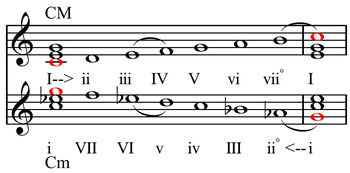

Neo-Riemannian theory is a loose collection of ideas present in the writings of music theorists such as David Lewin, Brian Hyer, Richard Cohn, and Henry Klumpenhouwer. What binds these ideas is a central commitment to relating harmonies directly to each other, without necessary reference to a tonic. Initially, those harmonies were major and minor triads; subsequently, neo-Riemannian theory was extended to standard dissonant sonorities as well. Harmonic proximity is characteristically gauged by efficiency of voice leading. Thus, C major and E minor triads are close by virtue of requiring only a single semitonal shift to move from one to the other. Motion between proximate harmonies is described by simple transformations. For example, motion between a C major and E minor triad, in either direction, is executed by an "L" transformation. Extended progressions of harmonies are characteristically displayed on a geometric plane, or map, which portrays the entire system of harmonic relations. Where consensus is lacking is on the question of what is most central to the theory: smooth voice leading, transformations, or the system of relations that is mapped by the geometries. The theory is often invoked when analyzing harmonic practices within the Late Romantic period characterized by a high degree of chromaticism, including work of Schubert, Liszt, Wagner and Bruckner.[1]
Neo-Riemannian theory is named after Hugo Riemann (1849–1919), whose "dualist" system for relating triads was adapted from earlier 19th-century harmonic theorists. (The term "dualism" refers to the emphasis on the inversional relationship between major and minor, with minor triads being considered "upside down" versions of major triads; this "dualism" is what produces the change-in-direction described above. See also: Utonality) In the 1880s, Riemann proposed a system of transformations that related triads directly to each other [2] The revival of this aspect of Riemann's writings, independently of the dualist premises under which they were initially conceived, originated with David Lewin (1933–2003), particularly in his article "Amfortas's Prayer to Titurel and the Role of D in Parsifal" (1984) and his influential book, Generalized Musical Intervals and Transformations (1987). Subsequent development in the 1990s and 2000s has expanded the scope of neo-Riemannian theory considerably, with further mathematical systematization to its basic tenets, as well as inroads into 20th century repertoires and music psychology.[1]
- ^ a b Cohn, Richard (Autumn 1998). "An Introduction to Neo-Riemannian Theory: A Survey and Historical Perspective". Journal of Music Theory. 42 (2): 167–180. doi:10.2307/843871. JSTOR 843871.
- ^ Klumpenhouwer, Henry (1994). "Some Remarks on the Use of Riemann Transformations". Music Theory Online (9). ISSN 1067-3040.